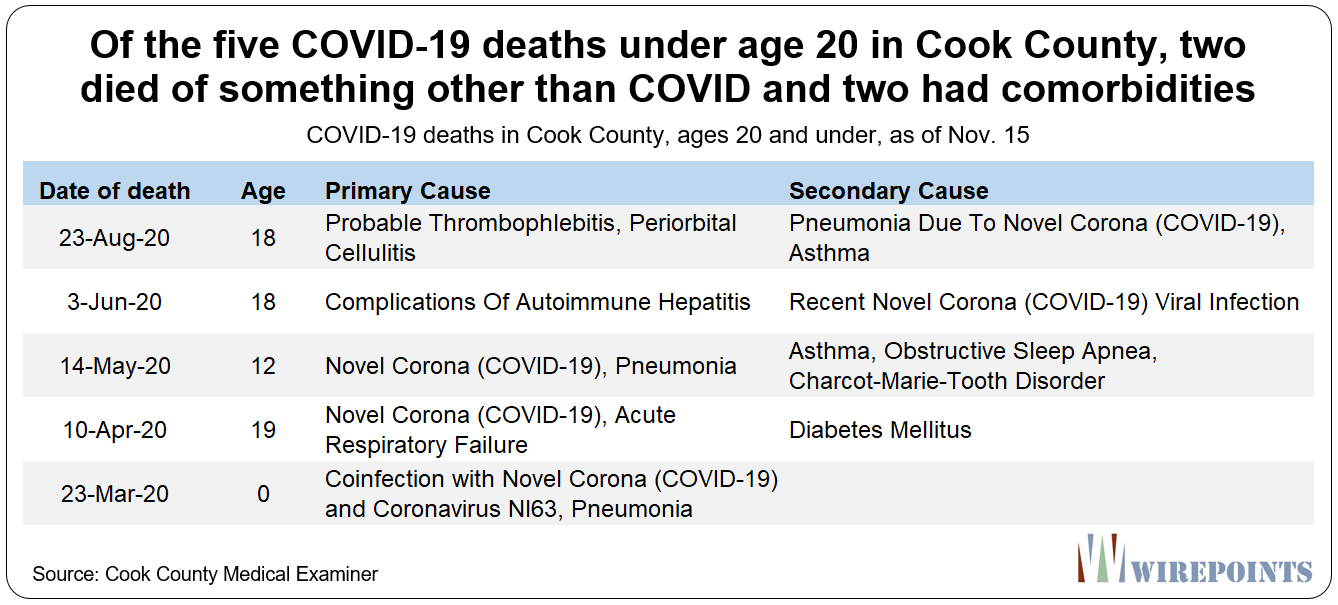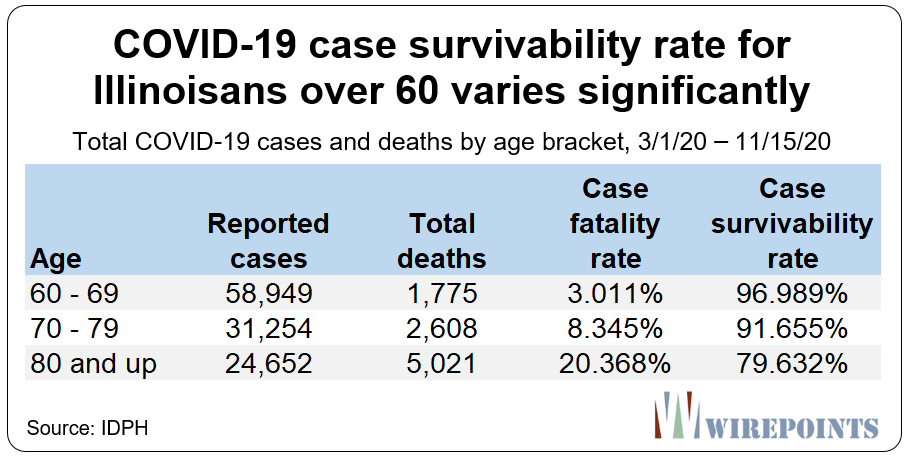Many Illinois school districts are shutting down in-class learning due to the jump in COVID cases, but another set of numbers argue that schools should stay open – and in fact, open even more.
A Wirepoints’ analysis of state COVID data finds the survival rate for Illinoisans younger than 20 is at 99.99%. For teacher-aged adults between the ages of 20-49, the survival rate is at 99.82%. That’s based on data directly from the Illinois Department of Public Health (IDPH).*
In other words, the majority of those most involved in K-12 education, including both students and teachers, are at far less risk than many have been led to believe.
The plain truth is that we are targeting the wrong group for protection. COVID risk is concentrated almost entirely on the elderly and those with certain comorbidities, not on school kids and not on most teachers and staff. We are punishing young people because of a risk to a different group in which children in classrooms play little to no role.
An increasing amount of data shows that transmission in schools is far lower than expected, especially as mitigations and testing regimes continue to improve.
It’s time to redirect our efforts to where the numbers point: Carefully protect the elderly and those with comorbidities and let children resume their education.
Fact 1. The survival rate from COVID for those younger than 20 is 99.99%.
There have been 8 total COVID-19 deaths in Illinois in the under-20 age bracket out of a known 80,000 cases. That puts the fatality rate at just 0.01%. Expressed in the opposite way, the survival rate of those who have been infected is 99.99%.

However, the actual survival rate is far higher than reported above because many asymptomatic cases have yet to be detected.
The CDC’s calculation of the true infection fatality rate, including its estimation of the number of cases not yet identified, results in a survival rate of 99.997% for those under the age of 20. Said in the opposite way, the CDC’s overall fatality rate estimate for that age group is just 0.003%.

Importantly, it’s also known that those with underlying conditions are the most at risk from the virus. CDC data shows that 94% of all COVID deaths in the U.S. are tied to some pre-existing condition, including diabetes, hypertension, obesity, heart disease, etc.
At least four of the eight Illinois children that died had comorbidities, meaning the survival rate for healthy, young Illinoisans is even higher. (Wirepoints could only access information for five of the eight deaths. Five youth died in Cook County, where its medical examiner publishes data on comorbidities. The state does not provide any detailed comorbidity data whatsoever, so the status of the other three deaths is unknown.)
 Unless and until the virus takes a different direction, the data shows that healthy school-age children are at very low risk and should be in school every day.
Unless and until the virus takes a different direction, the data shows that healthy school-age children are at very low risk and should be in school every day.
Fact 2. The survival rate for teacher-aged adults, ages 20-49, is 99.82%.
The survival rate for healthy, middle-aged Illinoisans has also been very high, according to reported case and death data from IDPH.
Take Illinoisans in their 20s. There have been 39 deaths out of 112,000 reported infections, for a survival rate of 99.965%. Said in the opposite way, the fatality rate for that age group is at 0.035%. The next age bracket, 30-39, has had a total of 147 deaths out of 93,000 known cases, for a survival rate of 99.841%.
Overall, the survivability rate for Illinoisans ages 20-49 has been 99.822% – a fatality rate of 0.178%.

The CDC’s estimated infection fatality rate for ages 20-49 is even lower at 0.02% (see CDC table in Fact 1).
That’s good news for teachers. According to data from the Illinois Teachers Retirement System, 77 percent of all teachers across the state are younger than 50. The data shows they can go back to teaching in the classroom with minimal risk.
 The fatality rate does become more significant in the brackets for ages 50 and above. For those 50 to 59, the rate is a little less than 1%. Teachers in that age bracket should assess their risk carefully – underlying conditions, etc. – to determine if they can remain physically in the classroom.
The fatality rate does become more significant in the brackets for ages 50 and above. For those 50 to 59, the rate is a little less than 1%. Teachers in that age bracket should assess their risk carefully – underlying conditions, etc. – to determine if they can remain physically in the classroom.
Fact 3. School transmission rates are low.
Students spreading the virus to their classmates, teachers and parents has been one of the biggest concerns about in-class learning since the beginning of the pandemic.
Initial data from around the world was mixed, though a majority showed that transmission rates were very low. Now several months later, more data is in. Emily Oster, an Economist at Brown University, recently wrote in the Atlantic that:
“Our data on almost 200,000 kids in 47 states from the last two weeks of September revealed an infection rate of 0.13 percent among students and 0.24 percent among staff. That’s about 1.3 infections over two weeks in a school of 1,000 kids, or 2.2 infections over two weeks in a group of 1,000 staff. Even in high-risk areas of the country, the student rates were well under half a percent.”
“These numbers are not zero, which for some people means the numbers are not good enough. But zero was never a realistic expectation. We know that children can get COVID-19, even if they do tend to have less serious cases. Even if there were no spread in schools, we’d see some cases, because students and teachers can contract the disease off campus. But the numbers are small—smaller than what many had forecasted.”
That study adds to a growing pile of research that shows children are not major vectors of the virus. For example, Science magazine reported a few months ago that “studies have found that overall, people under age 18 are between one-third and one-half as likely as adults to contract the virus, and the risk appears lowest for the youngest children.”
And a recent article in Nature reported that “data gathered worldwide are increasingly suggesting that schools are not hot spots for coronavirus infections. Despite fears, COVID-19 infections did not surge when schools and day-care centers reopened after pandemic lockdowns eased.”
Fact 4. The elderly are most at risk and should be protected
Shutting schools makes even less sense when you look at who has been most impacted by the coronavirus. The data shows the elderly and infirm are overwhelmingly the groups at risk from COVID.
Illinoisans over 60 have a case survivability rate of under 92% and account for over 87 percent of COVID deaths. They should be the focus of Illinois’ COVID mitigation policies.
 One of the worst aspects of the whole pandemic has been the failure of the state to protect elderly Illinoisans in retirement homes. Over half (52%) of all COVID-19 deaths in Illinois since the beginning of the pandemic are linked to Long-Term Care facilities.
One of the worst aspects of the whole pandemic has been the failure of the state to protect elderly Illinoisans in retirement homes. Over half (52%) of all COVID-19 deaths in Illinois since the beginning of the pandemic are linked to Long-Term Care facilities.
In fact, the most recent data from last week shows that LTC residents continue to dominate Illinois’ COVID deaths. Of the 425 COVID deaths that occurred during the week of Nov. 13, 56 percent were linked to retirement homes.
The facts and data say opening schools to in-classroom learning is safe
More and more expert opinion appears to be acknowledging what most parents have known for months: that the harm done by remote learning outweighs the risks of in-class learning.
As a recent piece on NPR noted: “Combined with anecdotal reports from a number of U.S. states where schools are open, as well as a crowdsourced dashboard of around 2,000 U.S. schools, some medical experts are saying it’s time to shift the discussion from the risks of opening K-12 schools to the risks of keeping them closed.”
The recent rise in COVID cases shouldn’t discourage parents, teachers and administrators from doing what’s best for students: returning them to, and keeping them in, the classroom. The science and data show that can be done safely and responsibly for all involved.
Keeping schools shut has had an increasingly negative impact on children’s lives. More and more evidence shows that children missing school is leading to isolation, anxiety, the loss of critical development time, and not to mention, lost instructional time – remote learning hasn’t worked. There’s also the increased risk of teen suicide and unreported child abuse.
COVID-19 is scary, particularly for the elderly and infirm, but unless the virus changes course, the data shows it’s safe for schools to open fully if done safely and responsibly.